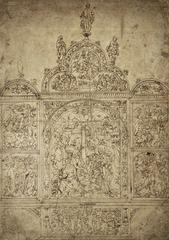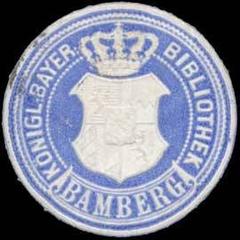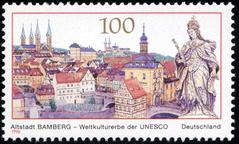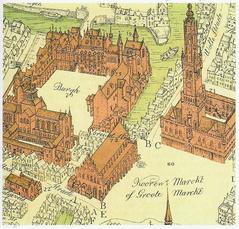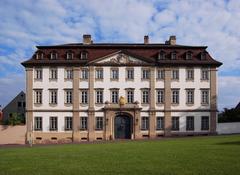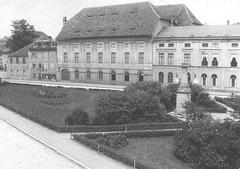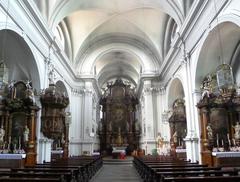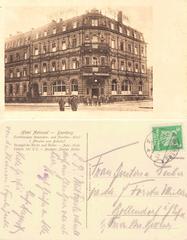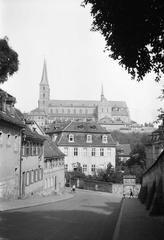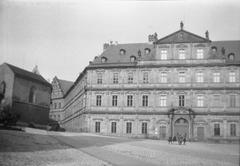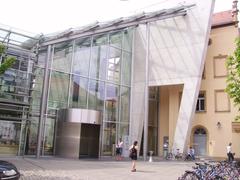
Bamberg Castles Visiting Hours, Tickets, and History Guide
Date: 04/07/2025
Introduction to Bamberg Castles and What to Expect When Visiting
In the heart of Bavaria, Bamberg stands as a living testament to over a thousand years of history, architectural brilliance, and cultural vibrancy. Recognized as a UNESCO World Heritage Site, Bamberg is celebrated for its remarkably preserved medieval townscape, highlighted by its castles and palaces. The city’s iconic sites—Altenburg Castle, the Old Court (Alte Hofhaltung), Lisberg Castle, Seehof Palace, and Geyerswörth Palace—reflect Bamberg’s transformation from a strategic medieval stronghold to a flourishing ecclesiastical and cultural hub.
These castles represent a spectrum of European architectural styles, from Romanesque and Gothic to Renaissance, Baroque, and Romantic, and embody Bamberg’s significance as the seat of the Prince-Bishops and a key center in the Holy Roman Empire. Visitors to Bamberg can expect sweeping panoramic views, intricate architectural details, and immersive exhibits, all set against the backdrop of vibrant local traditions, including a world-famous beer culture and a calendar full of lively festivals.
This guide provides all essential information for exploring Bamberg’s castles: detailed visiting hours, ticketing, accessibility, guided tours, and insider tips for engaging with Bamberg’s rich heritage. Whether ascending Altenburg’s historic keep, wandering the Renaissance courtyards of the Old Court, or strolling through the baroque gardens of Seehof Palace, each site offers unique experiences. For further planning, consult resources such as Germany Travel, PlanetWare, and Nomads Travel Guide.
Contents Overview
- Bamberg’s Historical Evolution: From Medieval Power Center to UNESCO Gem
- Exploring Bamberg’s Castles: Visiting Hours, Tickets, and Must-See Highlights
- Special Events, Guided Tours, and Photographic Highlights
- Accessibility and Travel Tips
- Preservation and UNESCO Recognition
- Visiting Altenburg Castle and Geyerswörth Palace: Hours, Tickets & Tips
- Cultural Insights and Events
- Practical Visitor Tips
- Notable Cultural Districts and Nearby Attractions
- Diversity and Inclusion in Bamberg’s Cultural Life
- FAQ
Bamberg’s Historical Evolution: From Medieval Power Center to UNESCO Gem
Early Foundations and Medieval Growth
Bamberg’s origins trace back to at least 902 AD, when it gained strategic and religious importance in the Franconian region (explorecity.life). Its location on the Regnitz River and position at key trade routes spurred its growth as a center for commerce and governance. The city’s stature increased dramatically in the 11th century under Emperor Henry II, who established Bamberg as a major hub of the Holy Roman Empire. The construction of the magnificent Bamberg Cathedral (Dom), a Romanesque masterpiece, remains a highlight of this era (germany.travel).
As the seat of the Prince-Bishops, Bamberg flourished in the Middle Ages, developing a distinctive architectural style and urban layout still visible in its old town, with its cobbled streets and picturesque half-timbered houses (planetware.com).
Exploring Bamberg’s Castles: Visiting Hours, Tickets, and Must-See Highlights
Altenburg Castle: Guardian of Bamberg
- Location: Altenburg 1, 96049 Bamberg
- Opening Hours: April–October, daily 10:00 AM–6:00 PM; November–March, weekends only 11:00 AM–4:00 PM
- Tickets: Adults €6, reduced €4, children under 6 free; group tours by appointment
- Accessibility: Hilltop location; access via uphill walk or taxi; limited wheelchair access
Altenburg Castle, perched atop Bamberg’s highest hill, dates to the early 12th century. Originally a defensive refuge, it later became the residence of the Prince-Bishops. Visitors can explore the 33-meter keep, medieval walls, and the signaling iron basket (planetware.com). The castle features panoramic terraces and a restaurant with sweeping city views.
The Old Court (Alte Hofhaltung): Renaissance Treasure
- Location: Domplatz 9, 96049 Bamberg
- Opening Hours: Tuesday–Sunday, 10:00 AM–5:00 PM; closed Mondays
- Tickets: Adults €5, reduced €3; combined tickets available
- Accessibility: Mostly wheelchair accessible with assistance
Built in the 16th century as the Prince-Bishops’ residence, the Old Court is a Renaissance gem. The “Beautiful Gateway” by Pankras Wagner and the tranquil courtyard, which hosts concerts and events, are highlights. The building houses the Bamberg Historical Museum, showcasing art and civic history (planetware.com).
Lisberg Castle: A Medieval Survivor Nearby
- Location: Schlossweg 1, 96170 Lisberg (12 km west of Bamberg)
- Visiting Info: Guided tours by appointment only; privately owned
- Tickets: Vary by tour; check current rates
Lisberg Castle, with roots as early as 820 CE, survived centuries of conflict. Visitors can see dungeons, the Gothic Women’s House, and a Renaissance-era Great Hall. Tours are by appointment only (planetware.com).
Seehof Palace: Baroque Elegance and Gardens
- Location: Schloss Seehof, Memmelsdorf, 5 km from Bamberg
- Opening Hours: April–October, Tuesday–Sunday, 10:00 AM–5:00 PM
- Tickets: Adults €4, reduced €2
Seehof Palace was built as a summer residence for the Prince-Bishops in the late 17th century and is noted for its Rococo gardens, cascades, and orangery (planetware.com).
Special Events, Guided Tours, and Photographic Highlights
Bamberg’s castles serve as venues for cultural events such as concerts, exhibitions, and the Sandkerwa festival (explorecity.life). Altenburg and the Old Court offer regular guided tours; Lisberg Castle requires advance booking.
Photographers enjoy panoramic cityscapes from Altenburg and the romantic ambiance of the Old Court’s courtyards, with the best light in the early morning or late afternoon.
Accessibility and Travel Tips
- Getting There: Altenburg Castle is a 20-minute uphill walk or short taxi ride from the city center. The Old Court and cathedral are centrally located.
- Accessibility: Some sites have limited wheelchair access due to historic terrain. Confirm details in advance.
- Best Time to Visit: May–September features the best weather, vibrant gardens, and a full event calendar (wanderineurope.com).
Preservation and UNESCO Recognition
Bamberg’s medieval core, with its castles and civic buildings, is recognized by UNESCO for its outstanding preservation and cultural value (germany.travel). Ongoing efforts ensure that these sites remain accessible and vibrant for visitors.
Visiting Altenburg Castle and Geyerswörth Palace: Hours, Tickets & Tips
Altenburg Castle (Burg Altenburg)
Historical Overview:
Altenburg Castle, atop Bamberg’s highest hill, has origins in the early 12th century (Meticulous Meanderings). Initially a defensive refuge, it became the prince-bishops’ residence in the 14th century. After destruction in the Second Margrave War and periods of disrepair, restoration began in the 19th century and continues today (Germany Trip Planning).
Architectural Features:
- 33-meter-high medieval tower, offering panoramic city views (Meticulous Meanderings)
- Restored chapel from 1834
- 30-meter-deep fountain in the gardens
- Original Knights’ Hall and romantic half-timbered additions
Visiting Information:
- Location: 96049 Bamberg, visible from much of the city (Bamberg Travel)
- Access: 30–45 minute hike from Old Town or short drive; limited parking (Germany Trip Planning)
- Opening Hours: Grounds open daily 9:00 AM–9:00 PM
- Admission: Grounds are free; interior tours require advance booking and a fee
- Guided Tours: Available in German and English, bookable online
- Accessibility: Some areas, especially the tower, involve stairs; contact ahead for details
- Dining: Restaurant temporarily closed as of 2024; dine in Old Town (Germany Trip Planning)
- Events: Hosts wine festivals and concerts; see official website
Visitor Tips:
- June–July is the best season for blooming gardens
- The tower and gardens are ideal for panoramic photography (Bamberg Travel)
- Combine with a walk through UNESCO-listed Old Town or nearby trails
Geyerswörth Palace (Schloss Geyerswörth)
Historical Background:
Near the Old Town Hall, Geyerswörth Palace was built in the 14th century and acquired by the Prince-Bishopric in 1580. The current complex dates to the late 16th century, blending Renaissance and Baroque styles. It is now owned by the city and used for administrative purposes (Bambergguide, Go Bamberg).
Features:
- Elegant Renaissance-Baroque architecture
- Meticulously landscaped gardens and courtyards (Evendo)
- Art collections and sculptures
- Tower with city views (closed for restoration as of 2025)
Visiting Information:
- Location: Geyerswörthstraße 3, 96047 Bamberg (Bamberg Info)
- Access: Walkable from city center; parking nearby
- Current Status: Closed for restoration as of July 2025
- Tours: Normally available; virtual options may be offered during closure
- Accessibility: Generally good, but limited during restoration
- Events: Occasionally hosts public events—check listings
Visitor Tips:
- The palace’s exterior and gardens are still photogenic even when closed
- Central location makes it a convenient stop during city tours
- Explore nearby Old Town attractions, including the Altes Rathaus and “Little Venice” (Time Travel Turtle)
Cultural Insights and Events
Bamberg Beer Culture and Festivals
Bamberg is famous for its Rauchbier (smoked beer) and hosts nine traditional breweries, including Schlenkerla and Spezial, with daily tastings and tours (happytowander.com). The Franconian Brewery Museum (in Michaelsberg Abbey) is open Tuesday–Sunday, 10 AM–5 PM.
Annual Festivals
- Bamberg Zaubert – International Street Festival (July)
- Wild Tunes Festival (July)
- Sommernachtsfest (July)
- Open Air Kino (July)
Tickets for events can be purchased online or at local centers (bamberg.info, allevents.in, bambergerfestivals.de).
Arts, Theater, and Museums
- Calderonspiele: Summer open-air theater
- Historisches Museum Bamberg: Tuesday–Sunday, 10 AM–5 PM
- Literary readings and concerts: Regularly scheduled (musik-dresden.de)
Culinary Traditions
Sample Bamberger Hörnla potatoes, stuffed onions, and Schäuferla (roast pork) at traditional taverns or open-air markets (thegeographicalcure.com).
Practical Visitor Tips
- Getting There: Bamberg is easily accessible by train; the central station is a 15-minute walk from Old Town.
- Accessibility: Most attractions are walkable, but cobblestones and hills may challenge those with mobility issues.
- Tickets: Purchase in advance for popular sites and events.
- Local Etiquette: Sharing tables in beer gardens is common.
- Accommodation: Book early during festivals (theinvisiblenarad.com).
Notable Cultural Districts and Nearby Attractions
- Klein-Venedig (Little Venice): Picturesque riverside district (touristguidemap.com)
- Altenburg Castle and Michaelsberg Abbey: Major historical landmarks (wanderineurope.com)
- Seehof Palace: Baroque residence with guided tours
- Day Trips: Franconian Switzerland for rock formations and outdoor activities
Diversity and Inclusion in Bamberg’s Cultural Life
Bamberg fosters diversity with events such as LGBTQIA+ guided museum tours and multicultural festivals (bamberg.info).
Frequently Asked Questions (FAQ)
Q: What are Bamberg’s main visiting hours?
A: Most museums and sites are open 9/10 AM–5/6 PM, with some variation.
Q: How can I buy tickets?
A: Online, at tourist offices, or onsite; advance booking is recommended during peak seasons.
Q: Are guided tours available?
A: Yes, in multiple languages, focusing on history, beer, and architecture.
Q: Is Bamberg accessible for visitors with mobility challenges?
A: Many venues offer wheelchair access, but some streets and historical sites may be difficult—check in advance.
Q: When is the best time to visit?
A: June–September for festivals and events; spring and autumn for fewer crowds.
Conclusion: Immerse Yourself in Bamberg’s Living Heritage
Bamberg’s castles encapsulate centuries of history, blending medieval fortification with Renaissance, Baroque, and Romantic artistry. Altenburg Castle’s commanding presence, the Old Court’s Renaissance elegance, Lisberg’s medieval resilience, Seehof’s Rococo gardens, and Geyerswörth Palace’s urban grandeur together provide a comprehensive journey through Bavarian history and culture.
Plan your visit by consulting official resources, securing tickets in advance, and enjoying Bamberg’s unique beer culture, festivals, and culinary delights. For up-to-date information and digital maps, download the Audiala app and follow our social media channels.
Sources and Further Reading
- This is a sample text. (https://www.planetware.com/tourist-attractions-/bamberg-d-ba-bam.htm)
- This is a sample text. (https://www.germany.travel/en/cities-culture/bamberg-sights.html)
- This is a sample text. (https://www.nomads-travel-guide.com/city/bamberg/)
- This is a sample text. (https://wanderineurope.com/explore-bambergs-scenic-castles-and-magnificent-palaces/)
- This is a sample text. (https://germanytripplanning.com/altenburg-bamberg/)
- This is a sample text. (https://bambergtravel.net/altenburg-castle-in-bamberg/)
- This is a sample text. (https://www.bamberg.info/veranstaltungskalender/)
- This is a sample text. (https://happytowander.com/visit-bamberg-guide/)










